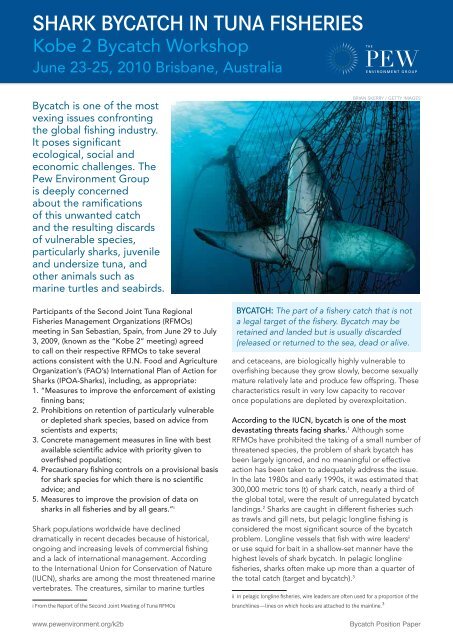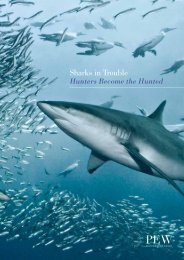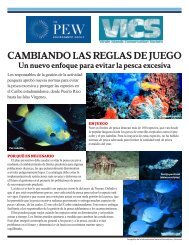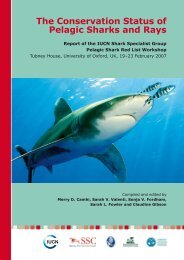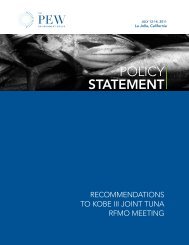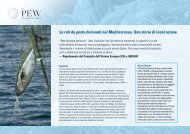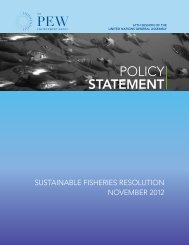SHARK BYCATCH IN TUNA FISHERIES
SHARK BYCATCH IN TUNA FISHERIES
SHARK BYCATCH IN TUNA FISHERIES
Create successful ePaper yourself
Turn your PDF publications into a flip-book with our unique Google optimized e-Paper software.
<strong>SHARK</strong> <strong>BYCATCH</strong> <strong>IN</strong> <strong>TUNA</strong> <strong>FISHERIES</strong><br />
Kobe 2 Bycatch Workshop<br />
June 23-25, 2010 Brisbane, Australia<br />
Bycatch is one of the most<br />
vexing issues confronting<br />
the global fishing industry.<br />
It poses significant<br />
ecological, social and<br />
economic challenges. The<br />
Pew Environment Group<br />
is deeply concerned<br />
about the ramifications<br />
of this unwanted catch<br />
and the resulting discards<br />
of vulnerable species,<br />
particularly sharks, juvenile<br />
and undersize tuna, and<br />
other animals such as<br />
marine turtles and seabirds.<br />
BRIAN SKERRY / getty images<br />
Participants of the Second Joint Tuna Regional<br />
Fisheries Management Organizations (RFMOs)<br />
meeting in San Sebastian, Spain, from June 29 to July<br />
3, 2009, (known as the “Kobe 2” meeting) agreed<br />
to call on their respective RFMOs to take several<br />
actions consistent with the U.N. Food and Agriculture<br />
Organization’s (FAO’s) International Plan of Action for<br />
Sharks (IPOA-Sharks), including, as appropriate:<br />
1. “Measures to improve the enforcement of existing<br />
finning bans;<br />
2. Prohibitions on retention of particularly vulnerable<br />
or depleted shark species, based on advice from<br />
scientists and experts;<br />
3. Concrete management measures in line with best<br />
available scientific advice with priority given to<br />
overfished populations;<br />
4. Precautionary fishing controls on a provisional basis<br />
for shark species for which there is no scientific<br />
advice; and<br />
5. Measures to improve the provision of data on<br />
sharks in all fisheries and by all gears.” i<br />
Shark populations worldwide have declined<br />
dramatically in recent decades because of historical,<br />
ongoing and increasing levels of commercial fishing<br />
and a lack of international management. According<br />
to the International Union for Conservation of Nature<br />
(IUCN), sharks are among the most threatened marine<br />
vertebrates. The creatures, similar to marine turtles<br />
i From the Report of the Second Joint Meeting of Tuna RFMOs<br />
<strong>BYCATCH</strong>: The part of a fishery catch that is not<br />
a legal target of the fishery. Bycatch may be<br />
retained and landed but is usually discarded<br />
(released or returned to the sea, dead or alive.<br />
and cetaceans, are biologically highly vulnerable to<br />
overfishing because they grow slowly, become sexually<br />
mature relatively late and produce few offspring. These<br />
characteristics result in very low capacity to recover<br />
once populations are depleted by overexploitation.<br />
According to the IUCN, bycatch is one of the most<br />
devastating threats facing sharks. 1 Although some<br />
RFMOs have prohibited the taking of a small number of<br />
threatened species, the problem of shark bycatch has<br />
been largely ignored, and no meaningful or effective<br />
action has been taken to adequately address the issue.<br />
In the late 1980s and early 1990s, it was estimated that<br />
300,000 metric tons (t) of shark catch, nearly a third of<br />
the global total, were the result of unregulated bycatch<br />
landings. 2 Sharks are caught in different fisheries such<br />
as trawls and gill nets, but pelagic longline fishing is<br />
considered the most significant source of the bycatch<br />
problem. Longline vessels that fish with wire leaders ii<br />
or use squid for bait in a shallow-set manner have the<br />
highest levels of shark bycatch. In pelagic longline<br />
fisheries, sharks often make up more than a quarter of<br />
the total catch (target and bycatch). 3<br />
ii In pelagic longline fisheries, wire leaders are often used for a proportion of the<br />
branchlines—lines on which hooks are attached to the mainline. 3<br />
www.pewenvironment.org/k2b<br />
Bycatch Position Paper
Discard mortality presents another very serious<br />
problem: Recent research on blue sharks estimated an<br />
annual average of more than 20,000 t of dead discards<br />
in the North Atlantic solely from pelagic longline<br />
fisheries, a number equal to the nominal catch reported<br />
to the International Commission for the Conservation<br />
of Atlantic Tunas by these fisheries. 4<br />
Sound, precautionary management of bycatch species<br />
is required to prevent population collapse, allow<br />
species recovery and maintain ecosystem function. It<br />
is vital that the tuna RFMOs take meaningful action<br />
to address this issue. However, current understanding<br />
of the impact of bycatch is profoundly inadequate<br />
because catch statistics are scarce and rarely include<br />
discards. This undermines effective conservation<br />
and management of high seas fisheries, particularly<br />
shark species. Shark catches are often unreported,<br />
underreported or recorded in generic species<br />
categories, contrary to Article 5(j) of the U.N. Fish<br />
Stocks Agreement (UNFSA). iii In essence, shark fishing<br />
on the high seas is illegal, unreported and unregulated.<br />
It is estimated that actual shark landings are three to<br />
four times higher than the catches reported to the<br />
FAO. 5 In 2007, only 20 percent of those shark-catch<br />
data were provided at species level. 6 As a result, the<br />
status and stock assessments of individual shark species<br />
are very difficult to determine.<br />
The Kobe 2 Bycatch Workshop provides a timely<br />
opportunity to improve the management of tuna<br />
fisheries on a global scale. The Pew Environment<br />
Group calls on participants to agree to concrete actions<br />
to minimize bycatch and discards and their impact<br />
on vulnerable species, and particularly to stop the<br />
overfishing of sharks by agreeing to strong actions<br />
that will address current problems on the high seas.<br />
iii Article 5(j): “[C]oastal States and States fishing on the high seas shall … collect and share,<br />
in a timely manner, complete and accurate data concerning fishing activities on, inter alia,<br />
vessel position, catch of target and non-target species and fishing effort, as set out in Annex<br />
I, as well as information from national and international research programmes.”<br />
RECOMMENDATIONS<br />
Accurately assess bycatch and discards.<br />
• RFMOs should adopt “No Data—No Fishing”<br />
requirements, so that any member nation failing to<br />
provide credible required information/data should<br />
be prohibited from fishing, particularly with regard to<br />
sharks.<br />
• In addition to reporting species-specific data on<br />
catches, effort by gear type, landings and trade,<br />
member states should report complete bycatch and<br />
discard (both dead and alive) information at the<br />
species level, particularly for all shark species.<br />
Immediately adopt precautionary management<br />
measures.<br />
• No retention of species at risk: When conservation<br />
and management plans are not in place, retention<br />
should be prohibited for species at risk, including<br />
target species and bycatch such as sharks.<br />
Additionally, RFMOs should agree to prohibit<br />
retention of any species listed in Appendix I of the<br />
Convention on International Trade in Endangered<br />
Species of Wild Fauna and Flora (CITES) or on the<br />
IUCN Red List of Threatened Species as Critically<br />
Endangered, Endangered or Vulnerable (the<br />
“Threatened” category).<br />
• Implement precautionary management measures:<br />
RFMOs should fully implement the precautionary<br />
approach by requiring and heeding advice from<br />
their scientific committees to include “limit” and<br />
“target” reference points that ultimately include<br />
dead discards for all species, including non-target<br />
species, especially shark species. When this advice is<br />
not available, no fishing should take place.<br />
• Adopt a “fins naturally attached” policy: In line<br />
with the Kobe 2 recommendation on improving the<br />
enforcement of finning bans, all tuna RFMOs should<br />
adopt “fins naturally attached” policies, because<br />
this method prevents circumvention of the law and<br />
photolibrary.com<br />
www.pewenvironment.org/k2b<br />
Bycatch Position Paper
provides the optimum conditions for monitoring and<br />
enforcement.<br />
• Implement marine protected areas (MPAs) and<br />
time-area closures: RFMOs should implement MPAs<br />
and time-area closures for fisheries management<br />
purposes in accordance with the best available<br />
scientific advice to protect ecologically or<br />
biologically significant areas, particularly to shark<br />
species.<br />
• Develop national plans of action for the<br />
conservation and management of sharks (NPOA-<br />
Shark): Consistent with FAO’s IPOA-Sharks, States<br />
should develop an NPOA-Shark if their vessels<br />
conduct directed fisheries for sharks or if their vessels<br />
routinely catch sharks in non-directed fisheries.<br />
Immediately implement bycatch mitigation<br />
methods<br />
• Mandatory gear modifications on pelagic longlines.<br />
o Ban on wire leader: Wire leaders are typically<br />
used in pelagic longline fisheries to maximize<br />
shark retention. 3 Use of this gear creates a de<br />
facto targeted fishery for sharks. In fisheries<br />
where a large proportion of caught sharks are<br />
killed either for retention or discarding, a ban on<br />
wire leaders would probably reduce shark fishing<br />
mortality because sharks would be more likely to<br />
escape before being hauled in.<br />
o Circle hooks: For marine turtles, tuna and several<br />
billfish and shark species, the use of circle hooks<br />
has been associated with lower rates of deephooking<br />
and subsequent serious injury, hence<br />
increasing post-release survival rates. Estimates<br />
suggest that several target and common bycatch<br />
species are two to five times more likely to survive<br />
capture on circle hooks than on J hooks. 7<br />
o Fish bait: Experimental trials and interviews with<br />
fishermen confirmed that using fish instead of<br />
squid as bait results in a significant decrease<br />
in shark catch rates (on the order of 30 to 40<br />
percent), particularly of blue sharks. 3<br />
• Mandatory gear modifications in other fisheries.<br />
o Turtle excluder devices (TED) in trawl fisheries:<br />
TEDs are a very effective gear modification to<br />
mitigate marine turtle bycatch that can also<br />
substantially reduce (by more than 85 percent) the<br />
numbers of large sharks and rays (longer than 1<br />
meter) caught. 8<br />
Establish greater cooperation across tuna RFMOs.<br />
• Undertake research: Member nations should<br />
expeditiously undertake fishing trials to determine<br />
the feasibility and effectiveness of appropriate<br />
combinations of other gear specifications, fishing<br />
practices and measures in reducing the bycatch,<br />
injury and mortality of sharks. Assessments should<br />
be conducted on the effects on the catch of<br />
target species, especially juvenile tunas and other<br />
bycatch species, and results shared with all RFMOs.<br />
Specifically research should focus on:<br />
o Shark deterrents—including magnetic,<br />
electropositive rare earth metals and electrical<br />
deterrents—that hold promise but require<br />
significantly more investigation and large-scale<br />
trials.<br />
o Other fishing methods, such as gill nets and<br />
trawls, tend to have high shark capture mortality;<br />
new gear designs such as increasing the gill net’s<br />
tension, bycatch reduction devices and spatial and<br />
temporal management should be further tested as<br />
effective and commercially viable shark avoidance<br />
methods.<br />
• Establish a joint RFMOs bycatch task force: To<br />
ensure greater cooperation, coordinated data<br />
sharing and collection among RFMOs, a joint<br />
task force focused on key bycatch species should<br />
be convened annually. This would assist with<br />
harmonizing the conservation and management<br />
measures and sharing research advances in a timely<br />
manner by each of the five tuna RFMOs.<br />
For more information: Matt Rand, Director, Global<br />
Shark Conservation, Pew Environment Group<br />
mrand@pewtrusts.org<br />
REFERENCES<br />
1 M.D. Camhi et al., The Conservation Status of Pelagic Sharks and Rays:<br />
Report of the IUCN Shark Specialist Group Pelagic Shark Red List Workshop,<br />
IUCN Species Survival Commission Shark Specialist Group (2007),<br />
http://cmsdata.iucn.org/downloads/ssg_pelagic_report_final.pdf.<br />
2 R. Bonfil, “World bycatches of sharks in high-seas fisheries: Appraising<br />
the waste of a resource,” In: Bycatch in Fisheries and Their Impact on the<br />
Ecosystems (Fisheries Center, University of British Columbia, Vancouver,<br />
2(1): 41-4 (1995).<br />
3 E. Gilman et al., Shark depredation and unwanted bycatch in pelagic<br />
longline fisheries: Industry practices and attitudes, and shark avoidance<br />
strategies, Western Pacific Regional Fishery Management Council (2007),<br />
www.wpcouncil.org/pelagic/Documents/Shark-Longline_Interactions_<br />
Report.pdf.<br />
4 S.E. Campana et al., “Bycatch and discard mortality in commercially<br />
caught blue sharks Prionace glauca assessed using archival satellite<br />
pop-up tags,” Marine Ecology Progress Series 387: 241-53 (2009), www.<br />
int-res.com/abstracts/meps/v387/p241-253/.<br />
5 S.C. Clarke et al., “Global estimates of shark catches using trade<br />
records from commercial markets,” Ecology Letter 9(10): 1115-26 (2006),<br />
www.ncbi.nlm.nih.gov/pubmed/16972875.<br />
6 M. Lack and G. Sant, Trends in Global Shark Catch and Recent<br />
Developments in Management, TRAFFIC International (2009), www.<br />
traffic.org/fish.<br />
7 E.H. Carruthers et al., “Estimating the odds of survival and identifying<br />
mitigation opportunities for common bycatch in pelagic longline<br />
fisheries,” Biological Conservation 142(11): 2620-30 (November 2009),<br />
http://discover-decouvrir.cisti-icist.nrc-cnrc.gc.ca/dcvr/ctrl?action=shwart<br />
&aix=0&aid=12247712.<br />
8 D. Brewer et al., “The impact of turtle excluder devices and bycatch<br />
reduction devices on diverse tropical marine communities in Australia’s<br />
northern prawn trawl fishery,” Fisheries Research 81: 176-88 (2006),<br />
www.sciencedirect.com/science?_ob=ArticleURL&_udi=B6T6N-<br />
4KN5JSY-2&_user=10&_coverDate=11%2F30%2F2006&_rdoc=1&_<br />
fmt=high&_orig=search&_sort=d&_docanchor=&view=c&_<br />
acct=C000050221&_version=1&_urlVersion=0&_userid=10&md5=bba0<br />
ccbaef42e72a9295baa092f8661b.<br />
www.pewenvironment.org/k2b<br />
Bycatch Position Paper


